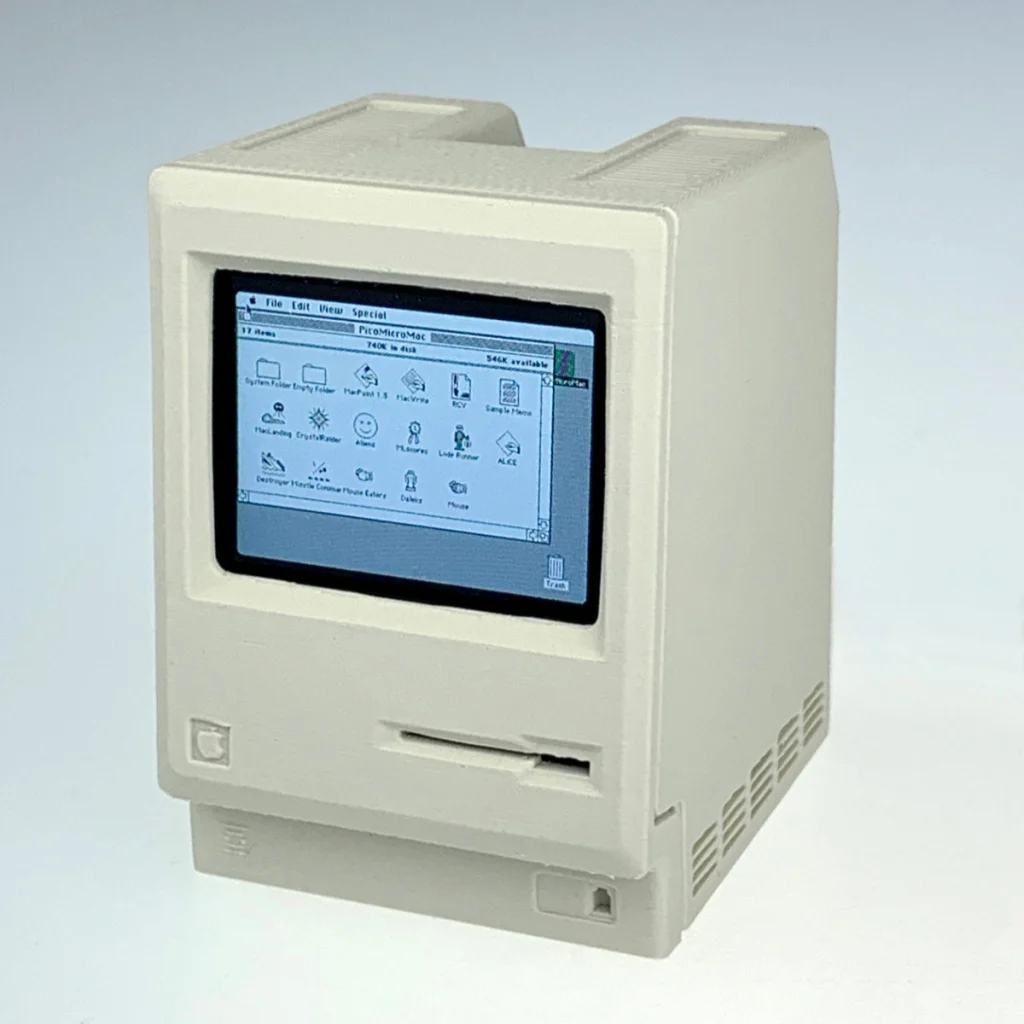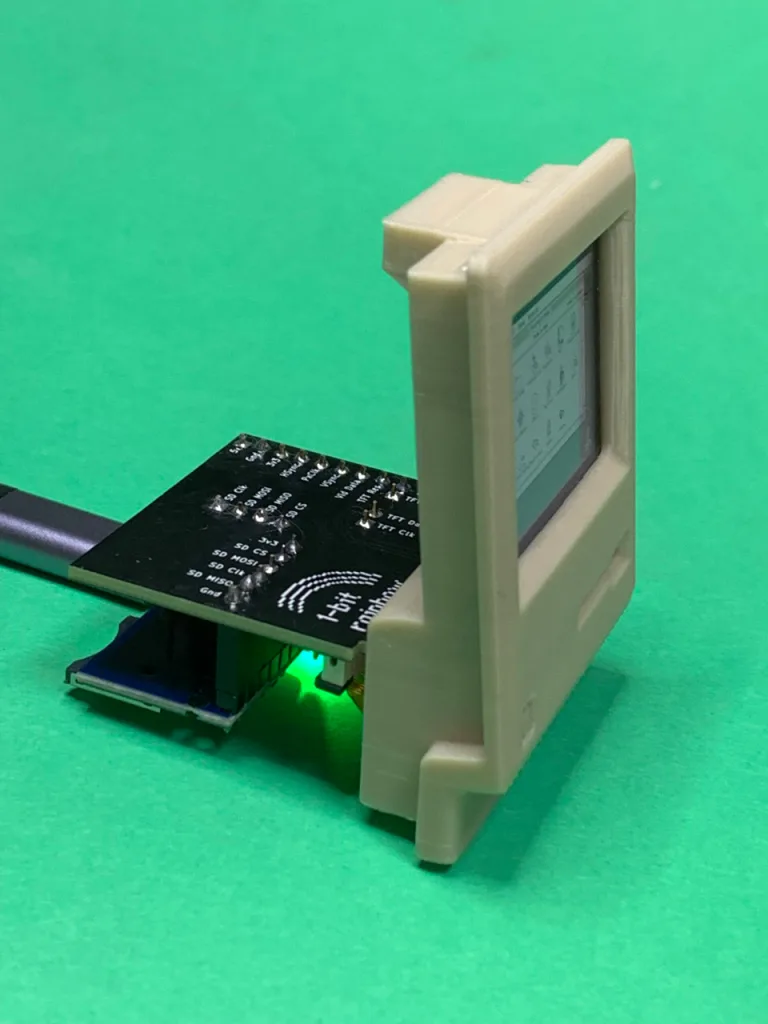This retro tech company made a functional 1984 Macintosh that’s 2 inches tall
For lovers of vintage Apple devices or anyone who grew up in the ’80s, a retro tech company just designed the ultimate throwback gadget: a working replica of the original 1984 Apple Macintosh that stands at just 62 millimeters tall. The device, called the “pico-mac-nano,” was created by retro tech enthusiast Nick Gillard for his website, 1-bit rainbow, which specializes in sourcing vintage Apple components. The mini computer is about half the size of a Coke can, comes in an ultra-detailed 3D-printed case, and has a single USB port that can be used for power and to connect a keyboard or mouse. Currently, it’s available online for backorder at just over $63, though Gillard has also compiled a detailed breakdown of all the components he used for any intrepid DIYers at home. In a blog post on the pico-mac-nano, Gillard explains that he was inspired by “the early days of computers, like the first Macintosh, when pioneers achieved remarkable things within the technological limitations of the day.” His version of the computer is a testament to just how much those technological limitations have evolved in the last 40 years. [Photo: 1-Bit Rainbow] Rebooting the first-ever Macintosh design Gillard, who is now 59, says his interest in vintage Apple products began when personal computers first started appearing during his school days. “My school had a Commodore PET, and I bought an Acorn Atom, so I’ve lived through this revolution and I’m pretty nostalgic about those early days of computing,” Gillard says. In 2006, Gillard started his own Apple parts company, The Bookyard Ltd., which sold modern Apple components for 15 years. After selling the company in 2021, Gillard started 1-bit rainbow this past November as an offshoot that focuses on Apple tech 25 years or older—a specialty that led him to conceptualizing the tiny 1984 Macintosh. [Photo: 1-Bit Rainbow] According to Gillard’s blog post, the idea to build a pico-mac-nano came from fellow retro tech enthusiast Matt Evans. In 2024, Evans created a system he called the Pico MicroMac, which could emulate the capabilities of the earliest Macintosh 128K (including applications like MacPaint, MacDraw, and MacWrite) on a modern desktop computer. Gillard followed Evans’ explanation of the revived Macintosh to build his own version at home. “Needless to say, I set about building a pico-mac and am not ashamed (slightly ashamed) to say I giggled like a little girl when that black & white, 512 x 342 pixel Macintosh desktop appeared on my VGA monitor and I launched Lode Runner,” Gillard wrote in a blog post. Still, he said, the experience had him thinking: “How much cooler would it be if pico-mac could drive a small LCD panel in a miniature replica Macintosh case?” The concept of building a scaled-down version of the design seemed possible, given that Evans’ Macintosh emulator was powered by Raspberry Pi’s RP2040 chip—a tiny microcontroller measuring just 7 by 7 millimeters. “As soon as I had it working and connected to a VGA monitor, it just screamed to be put in a little Macintosh case with an LCD,” Gillard says. [Photo: 1-Bit Rainbow] Designing the pico Mac nano, a 2″ computer To build his pico-mac-nano, Gillard started by searching for a mini LCD display screen that could load an approximation of the original Macintosh screen buffer, which featured a resolution of just 512 x 342 pixels (today’s 13-inch MacBook Air, by comparison, boasts a resolution of 2560 x 1664 pixels.) After some trial and error, Gillard ended up with a two-inch screen featuring a slightly less accurate resolution of 480 x 342 pixels, with the trade-off being that this option also allowed him to make the whole Macintosh even smaller. [Photo: 1-Bit Rainbow] With the LCD display as a touchpoint for scale, Gillard then used a 3D printer to make a 62 millimeter-tall plastic casing based on the structure of the original Macintosh, down to the ridges on top of the computer and the floppy disk slot on its front panel. On the inside of the rear case, Gillard added an embossed 1-bit rainbow logo where the original Macintosh team’s signatures would’ve been. The finished pico-mac-nano comes with a micro-SD card slot for memory storage and a single USB port, which, using a special splitter cable (also available at 1-bit rainbow), can both charge the device and make it compatible with a keyboard at the same time. Gillard has also designed a separate battery power module specifically for the device, “so you can whip it out of your pocket and wow your friends at parties.” The computer even comes packaged in a tiny version of the instantly recognizable “Picasso” box that the original Macintosh 128K shipped in. For those interested in purchasing the pico-mac-nano, Gillard warns in his blog that the device was designed as a proof-of-concept, not a finished product, and that it’s not necessarily guaranteed to run all early Macintosh software. Even so, chances a

For lovers of vintage Apple devices or anyone who grew up in the ’80s, a retro tech company just designed the ultimate throwback gadget: a working replica of the original 1984 Apple Macintosh that stands at just 62 millimeters tall.
The device, called the “pico-mac-nano,” was created by retro tech enthusiast Nick Gillard for his website, 1-bit rainbow, which specializes in sourcing vintage Apple components. The mini computer is about half the size of a Coke can, comes in an ultra-detailed 3D-printed case, and has a single USB port that can be used for power and to connect a keyboard or mouse. Currently, it’s available online for backorder at just over $63, though Gillard has also compiled a detailed breakdown of all the components he used for any intrepid DIYers at home.
In a blog post on the pico-mac-nano, Gillard explains that he was inspired by “the early days of computers, like the first Macintosh, when pioneers achieved remarkable things within the technological limitations of the day.” His version of the computer is a testament to just how much those technological limitations have evolved in the last 40 years.

Rebooting the first-ever Macintosh design
Gillard, who is now 59, says his interest in vintage Apple products began when personal computers first started appearing during his school days.
“My school had a Commodore PET, and I bought an Acorn Atom, so I’ve lived through this revolution and I’m pretty nostalgic about those early days of computing,” Gillard says.
In 2006, Gillard started his own Apple parts company, The Bookyard Ltd., which sold modern Apple components for 15 years. After selling the company in 2021, Gillard started 1-bit rainbow this past November as an offshoot that focuses on Apple tech 25 years or older—a specialty that led him to conceptualizing the tiny 1984 Macintosh.

According to Gillard’s blog post, the idea to build a pico-mac-nano came from fellow retro tech enthusiast Matt Evans. In 2024, Evans created a system he called the Pico MicroMac, which could emulate the capabilities of the earliest Macintosh 128K (including applications like MacPaint, MacDraw, and MacWrite) on a modern desktop computer. Gillard followed Evans’ explanation of the revived Macintosh to build his own version at home.
“Needless to say, I set about building a pico-mac and am not ashamed (slightly ashamed) to say I giggled like a little girl when that black & white, 512 x 342 pixel Macintosh desktop appeared on my VGA monitor and I launched Lode Runner,” Gillard wrote in a blog post.
Still, he said, the experience had him thinking: “How much cooler would it be if pico-mac could drive a small LCD panel in a miniature replica Macintosh case?” The concept of building a scaled-down version of the design seemed possible, given that Evans’ Macintosh emulator was powered by Raspberry Pi’s RP2040 chip—a tiny microcontroller measuring just 7 by 7 millimeters.
“As soon as I had it working and connected to a VGA monitor, it just screamed to be put in a little Macintosh case with an LCD,” Gillard says.

Designing the pico Mac nano, a 2″ computer
To build his pico-mac-nano, Gillard started by searching for a mini LCD display screen that could load an approximation of the original Macintosh screen buffer, which featured a resolution of just 512 x 342 pixels (today’s 13-inch MacBook Air, by comparison, boasts a resolution of 2560 x 1664 pixels.) After some trial and error, Gillard ended up with a two-inch screen featuring a slightly less accurate resolution of 480 x 342 pixels, with the trade-off being that this option also allowed him to make the whole Macintosh even smaller.

With the LCD display as a touchpoint for scale, Gillard then used a 3D printer to make a 62 millimeter-tall plastic casing based on the structure of the original Macintosh, down to the ridges on top of the computer and the floppy disk slot on its front panel. On the inside of the rear case, Gillard added an embossed 1-bit rainbow logo where the original Macintosh team’s signatures would’ve been.
The finished pico-mac-nano comes with a micro-SD card slot for memory storage and a single USB port, which, using a special splitter cable (also available at 1-bit rainbow), can both charge the device and make it compatible with a keyboard at the same time. Gillard has also designed a separate battery power module specifically for the device, “so you can whip it out of your pocket and wow your friends at parties.” The computer even comes packaged in a tiny version of the instantly recognizable “Picasso” box that the original Macintosh 128K shipped in.
For those interested in purchasing the pico-mac-nano, Gillard warns in his blog that the device was designed as a proof-of-concept, not a finished product, and that it’s not necessarily guaranteed to run all early Macintosh software.
Even so, chances are the pico-mac-nano is destined to become the ultimate collector’s item. In an era when iPods have become a popular example of “vintage tech,” the world’s tiniest workable Macintosh is a concept in a league of its own.

































































































































































